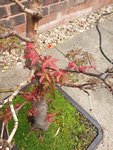There are lots of possible pathogens. Two that come to mind are nectria canker and pseudomonas syrangae.
Nectria primarily infests the phloem (inner bark) and so progresses downward from a wound. Were this nectria the top of your tree would have suddenly died late last summer and then been covered with little orange fruiting bodies for a few weeks.
Psuedomonas syrangae is a bacterium that tends to gain entry in winter by being a nucleation site for water crystalization. The crystals make small wounds in the bark through which the bacterium then infects the cambium. It is usually associated with blackish oozy bark necroses after a freezing rain.
Then there is fusarium wilt and etc., etc. You may need a lab analysis to definitively identify exactly what killed the top of your tree. Nevertheless, physical observations of the association of tissue damage and discoloration are a central part of the analysis.
And, it is also possible that no pathogen is involved. Outcomes similar to this are possible if the top of the tree was in bright sun and exposed to drying winds over the winter. I know nothing of its wintering nor of your climactic conditions.
The bottom line is, if it is a pathogen in the phloem, death will continue moving downward. You had best chop it below the line of death or you are going to just watch it die a little lower each day. If it is a pathogen in the xylem, what is dead is dead, but at some point the pathogen will release spores and potentially infect any and every thing that can be and is near by. Lastly, there may be no pathogenic cause. Then the top of the tree is just dead and will forever be dead. There is no mechanism for it to spring back to life. It can only rot.
So, there is little need to do anything other than watch, for now.


